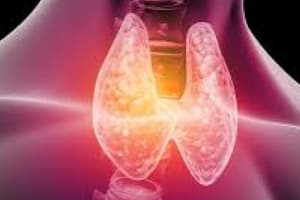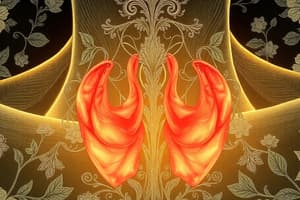Podcast
Questions and Answers
Which clinical manifestation indicates hypocalcemia?
Which clinical manifestation indicates hypocalcemia?
- Increased serum calcium levels
- Elevated serum phosphate
- High serum PTH levels
- Positive Chvostek's sign (correct)
What is typically observed in the serum of a patient with hypoparathyroidism?
What is typically observed in the serum of a patient with hypoparathyroidism?
- Decreased serum calcium levels (correct)
- Increased serum PTH levels
- Elevated serum calcium levels
- Decreased serum phosphate levels
Which of the following statements about hyperthyroidism is accurate?
Which of the following statements about hyperthyroidism is accurate?
- It is characterized by low serum PTH levels.
- It leads to decreased heart rate.
- It causes a decrease in body temperature.
- It can potentially lead to a thyroid storm. (correct)
In the context of hypoparathyroidism, which of the following would you expect to find?
In the context of hypoparathyroidism, which of the following would you expect to find?
What laboratory findings are characteristic of hypothyroidism?
What laboratory findings are characteristic of hypothyroidism?
What is a typical laboratory finding in a patient with hyperparathyroidism?
What is a typical laboratory finding in a patient with hyperparathyroidism?
Which pharmacological agent is used to inhibit osteoclastic bone resorption in hyperparathyroidism?
Which pharmacological agent is used to inhibit osteoclastic bone resorption in hyperparathyroidism?
Which of the following symptoms is likely NOT associated with hyperparathyroidism?
Which of the following symptoms is likely NOT associated with hyperparathyroidism?
Which nursing consideration is important for a patient taking bisphosphonates?
Which nursing consideration is important for a patient taking bisphosphonates?
In managing hyperparathyroidism, which of the following is a primary reason for using loop diuretics like Furosemide?
In managing hyperparathyroidism, which of the following is a primary reason for using loop diuretics like Furosemide?
What effect does increased serum calcium have on phosphorus levels in the body?
What effect does increased serum calcium have on phosphorus levels in the body?
Which laboratory finding is typically indicative of a chronic condition related to hyperparathyroidism?
Which laboratory finding is typically indicative of a chronic condition related to hyperparathyroidism?
What is a common complication of untreated hyperparathyroidism?
What is a common complication of untreated hyperparathyroidism?
Flashcards are hidden until you start studying
Study Notes
Anatomy and Physiology
Thyroid Gland
- Responsible for producing hormones that regulate metabolism, growth, and development.
Parathyroid Gland
- Functions primarily to regulate calcium levels in the blood and bone metabolism.
Disorders of the Parathyroid Gland
Hyperparathyroidism
- Condition characterized by excessive secretion of parathyroid hormone (PTH).
Clinical Manifestations and Complications
- May lead to hypercalcemia, kidney stones, osteoporosis, and neuromuscular symptoms.
Diagnostics
- Serum PTH: Increased
- Serum Calcium: Increased
- Serum Phosphate: Decreased (normal range: 2.5-4.5 mg/dL)
- Urine Calcium: Increased
- Bone Density: Decreased
Management
- Focuses on correcting calcium imbalance and addressing underlying causes.
Pharmacology
- Loop Diuretics (Furosemide): Increases urinary excretion of calcium.
- Bisphosphonates (Alendronate - Fosamax): Inhibits bone resorption, normalizes serum calcium, and improves bone density; IV forms can quickly lower high calcium levels. Administration notes include taking with a full glass of water, 30 minutes before meals, and avoiding lying down for 30 minutes.
- Phosphates: Administered for low phosphate levels; renal function monitoring is crucial.
Nursing Management
- Focus on monitoring calcium and phosphate levels and educating patients on dietary modifications.
Hypoparathyroidism
- Characterized by insufficient parathyroid hormone leading to low calcium levels.
Clinical Manifestations
- Symptoms include muscle cramps, tetany, and potential seizures.
Diagnostics
- Serum PTH: Decreased (normal range: 10-65 pg/mL)
- Serum Calcium: Decreased
- Serum Phosphate: Increased (normal range: 2.5-4.5 mg/dL)
Nursing Management
- Emphasis on calcium replacement therapy and education on dietary sources of calcium and vitamin D.
Disorders of the Thyroid Gland
Hyperthyroidism
- Condition of excessive thyroid hormone production; can lead to a thyroid storm, a severe life-threatening condition.
Clinical Manifestations
- Symptoms include weight loss, increased appetite, anxiety, insomnia, and heat intolerance.
Diagnostics
- Typically includes blood tests for thyroid hormones (TSH, T3, T4).
Interventions
- Management may involve antithyroid medications, radioactive iodine, or surgery.
Hypothyroidism
- Characterized by insufficient thyroid hormone production.
Clinical Manifestations
- Symptoms include fatigue, weight gain, cold intolerance, and depression.
Diagnostics
- Blood tests for elevated TSH and low T3 and T4 levels.
Management
- Treatment typically includes levothyroxine replacement therapy for hormone regulation.
Nursing Management
- Monitoring for medication adherence and effectiveness, and educating about dietary adjustments to support thyroid health.
Studying That Suits You
Use AI to generate personalized quizzes and flashcards to suit your learning preferences.




